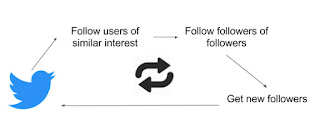Introduction
Twitter has become the most used social network for discovering real - time information on the Web - be it related to music, celebrities, news or anything else and hence twitter search is becoming more and more common. Since Twitter has increased rapidly, and now has over 330 million users, it has become a target for link farming.
Link Farming on Twitter is users trying to get large number of followers so that it increases the ranking of their tweets. Search engines rank users by follower-rank and Pagerank to decide whose tweets it will return in the search results. A higher in-degree (number of followers) means a better rank. Hence the motivation of a link farmer is to increase its in-degree since following-back is considered a social etiquette.
In this project we aim to analyse how a link farmer actually works on twitter and how it impacts their influence on the Web. We also made a web-app using which users can authorize their profile and use our scripts to get followers.
Methodology
- We used an already active account(@gureks) which had around 37 following and 27 followers when we started this project. We used Twython Twitter API to extract the tweets this account had already used. Hence using these hashtags we found people of similar interests i.e. people who had also used these hashtags.
- We then followed all these users and also followed their followers. This gave us a dataset of around 1500 users to follow. We followed them all but hit a roadblock. Most of these accounts were celebrity accounts, had a high in-degree to out-degree ratio or were inactive accounts and hence we didn't get much follow-backs. Hence we had to filter out some of the accounts by checking in-degree to out-degree ration and the activity of the accounts for the past 6 months. If activity was zero for that duration we defined it as inactive.
- We got a filtered dataset of about 800 users. The remaining 1500-800 = 700 users were unfollowed. In the meantime we had received 15 follow-backs. We followed followers of these 15 users which were around 250. When we followed these, we started getting many follow-backs and it increased exponentially.
Analysis and Results
We followed a total of 1800 users and gained 500 followers over a period of 15 days. Atleast 80% of our followers had an in-out degree ratio ranging from 0.5 - 1.5, which is a characteristic of a perfect link farmer. We also found that most of the link farmers are verified and highly active users that use link farming to increase their social capital and influence.
Following are some graphs we made :
 |
| Followers to Following ratio graph. |
 |
| A CDF graph showing that 80% of followers had in-out degree ratio ranging from 0.5-1.5 |
Poster Presentation
 |
| Our Team with our professor Mr. Ponnurangam. |
 |
| Our Poster |
Our Team
 |
| The Team (From left to Right): Atul Mathur, Hemant Rattey, Gurek Singh, Kartik Mathur. |


Comments
Post a Comment